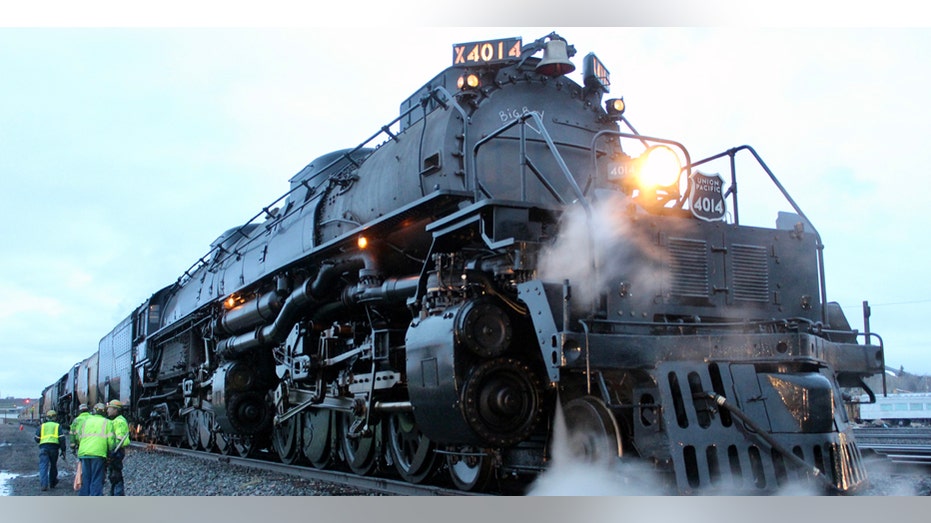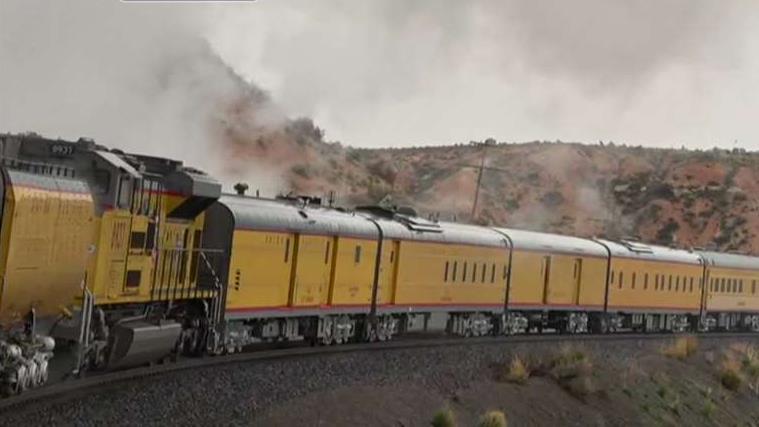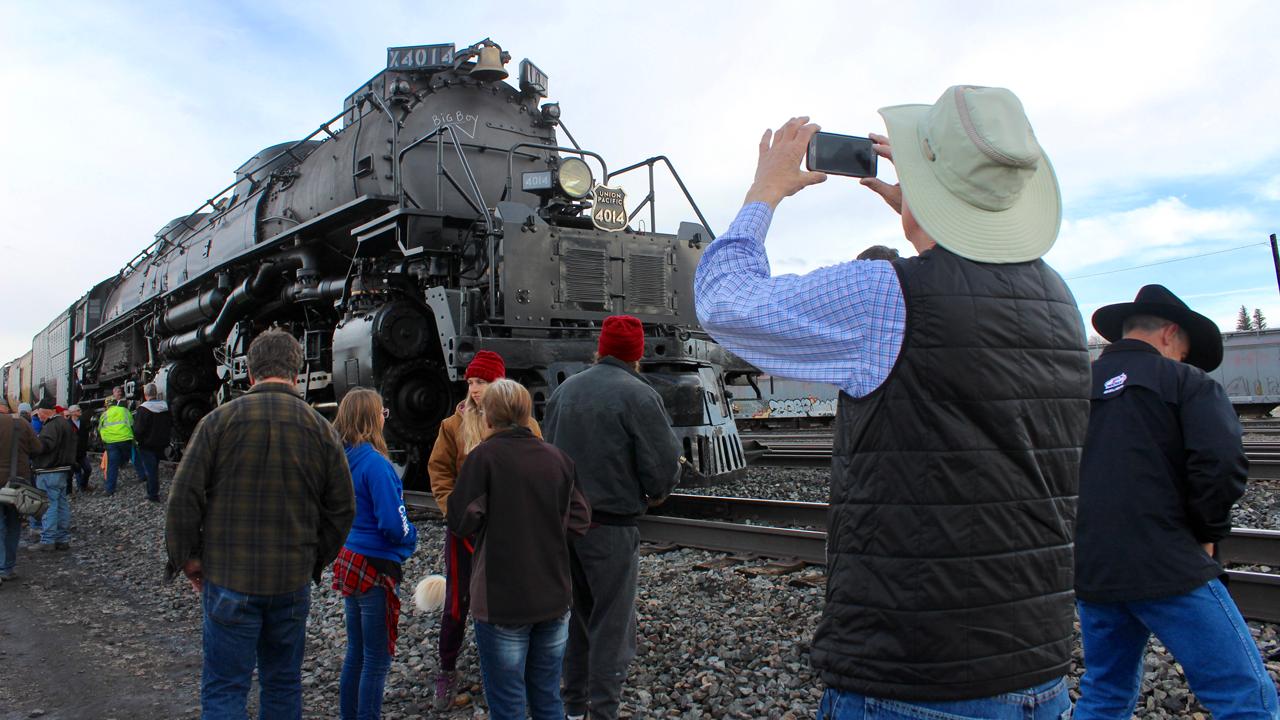A train ticket that takes a century and a half to get
It was a train ride 150 years in the making.
With steam blasting from its sides, and a mighty roar of the whistle, enthusiasts, curiosity seekers and history buffs on Wednesday watched a restored Union Pacific locomotive depart Evanston, Wyoming, on a journey marking a seminal moment in America’s history.
“It’s an amazing piece of machinery,” said Chris Cannon, a self-described train buff visiting from Fredericksburg, Virginia. “For years, people were saying one would never be rebuilt, and now, here it is.”
The “Big Boy” locomotive, developed in the 1940s as the world’s largest steam-powered engine, returned to the rails to commemorate the creation -- and construction -- of a rail system from the Atlantic to the Pacific.
Called the “Transcontinental Railroad,” it spawned the American rail industry, linked the industrializing East with the developing West, and helped to build a country recovering from a period of devastating Civil War.
On the eve of the railroad’s 150th anniversary, the Union Pacific No. 4014, just one of 25 “Big Boys” ever produced, thundered from southwest Wyoming to Ogden, Utah, as spectators gathered along the route to catch a glimpse.
“I’ve known about the Big Boys ever since I became a buff,” Cannon added. “It’s one of the most popular and important steam locomotives ever made.”
LOOKING BACK
The completion of the railroad, many historians argue, was the country’s most significant technological achievement of the 19th century, and quite possibly remained so until the moon landing 100 years later.
The endeavor began in 1862 with the Pacific Railway Act signed by President Abraham Lincoln. Construction got underway in January of the following year.
The legislation authorized two railroad companies – one in California, another in Nebraska – to build a single rail line across the breadth the country’s vast western expanse, ushering in the first railroad to span a continent.
Union Pacific laid its first ties in Omaha, where the company remains headquartered to this day, and built west. Meanwhile, workers from the Central Pacific Railroad of California initiated the same task in Sacramento, heading east.
In May 1869, workers met in Utah, having completed more than 1,900 miles of track. At that spot, now part of a national historical park near present-day Ogden, they would lay the final piece rail, celebrated with an 18-karat golden spike.
“There are very few companies in the world that have been around for 150 years,” Union Pacific President and CEO Lance Fritz told FOX Business, “let alone ones that have the direct link to their country like we do.”
BIRTH OF A RAILROAD INDUSTRY
In the 150 years since the Transcontinental Railroad's creation, the American railroad industry has developed dramatically and profoundly.
According to the Association of American Railroads, the industry’s lobbying consortium in Washington, the U.S. now operates 600 freight railroads, as part of a vast 140,000-mile nationwide system.
In 2017, the industry generated nearly $74 billion in revenue, moving among its freight 13.7 million intermodal containers, 4.5 million carloads of coal and 1.6 million carloads of farm products. And as international trade has continued to expand, railroad company revenues have jumped 26 percent in the past 10 years, according to Transportation Department statistics.
Trains carry both outbound goods to American ports for export, along with incoming consumer and industrial products from places like China.

A newly restored Union Pacific Big Boy locomotive returns to the rails after a five-year refurbishment. (Jason Racki/FOX Business)
TRADE CONCERNS
Despite this, trade has emerged as a worrisome issue to the nation’s railroad companies.
Amid U.S. trade fights with China, Mexico and the European Union, Union Pacific in the first quarter of 2019 reported that revenues from agricultural freight fell 3 percent compared to a year ago. As Chinese buyers turned away from more expensive American soybeans and pork, shipments to West Coast ports have sagged.
Fritz says Union Pacific has seen an “impact on trade flow” as a consequence of the trade battle, calling the tariffs “a very blunt instrument” with “real” effects on the nation’s economy.
“We are not a fan of tariffs,” Fritz said.
But perhaps even more importantly, Fritz says his company’s focus has been on the newly negotiated USMCA agreement with Canada and Mexico. The “United States-Mexico-Canada Agreement” is designed to take the place of the 1990s-era NAFTA pact, which President Trump has called “the worst trade deal ever approved.”
CLICK HERE TO GET THE FOX BUSINESS APP
Today, Union Pacific’s arteries extend not just west, but south. The company’s rail map blankets portions of Northern and Central Mexico, extending from major ports of entry along the U.S. border, down to the industrial coastal city of Veracruz.
However, the USMCA has run into potential hurdles in Congress, with even some Republican members warning that if U.S.-imposed steel and aluminum tariffs against Mexico aren’t first lifted, the deal could fail to reach ratification.
“It’s critical that the U.S. Congress ratify the USMCA,” Fritz said. “It is a better deal. It has modernized many aspects of NAFTA. That’s a great thing. Now, at this point, we need to move forward.”
GOLDEN MOMENT
But in the town of Ogden, set at the base of a range of mountains, onlookers are more interested in the past than the present.
On Thursday, the Big Boy No. 4014 will meet another Union Pacific train, the Living Legend No. 844, at the site of the Golden Spike. The locomotives, as they join together, will represent the meeting of western and eastern segments of the line at the same spot workers did in 1869.
“We built America,” Fritz added. “We’ve been doing it for 15 decades, and we look forward to doing it for 15 more.”
As the No. 4014 sat poised for the trip to Ogden, spectators marveled at the imposing size of the shiny Big Boy locomotive, weighing approximately 1.2 million pounds.
“To me, this was like the greatest steam locomotive like there ever was,” said Paul Browning, another train lover from Heber Valley, Utah. “It’s just the biggest, heaviest, most powerful steam locomotive in history. What a sight.”





















